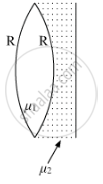Advertisements
Advertisements
Question
A child has near point at 10 cm. What is the maximum angular magnification the child can have with a convex lens of focal length 10 cm?
Solution
Given:
Distance of near point, D = 10 cm
Focal length, f = 10 cm
When the image is formed at the near point, D = 10 cm, the magnifying power (m) of a simple microscope is given as:
` m = 1+D/f`
= `1+10/10 = 1+1 =2`
Thus, the maximum angular magnification is 2.
APPEARS IN
RELATED QUESTIONS
A biconvex lens with its two faces of equal radius of curvature R is made of a transparent medium of refractive index μ1. It is kept in contact with a medium of refractive index μ2 as shown in the figure.

(a) Find the equivalent focal length of the combination.
(b) Obtain the condition when this combination acts as a diverging lens.
(c) Draw the ray diagram for the case μ1 > (μ2 + 1) / 2, when the object is kept far away from the lens. Point out the nature of the image formed by the system.
A biconvex lens made of a transparent material of refractive index 1.5 is immersed in water of refractive index 1.33. Will the lens behave as a converging or a diverging lens? Give reason.
Define the magnifying power?
name the factors on which 'limit of resolution' depends ?
The size of an object as perceived by an eye depends primarily on
A simple microscope has a magnifying power of 3.0 when the image is formed at the near point (25 cm) of a normal eye. (a) What is its focal length? (b) What will be its magnifying power if the image is formed at infinity?
The angular magnification of a system is less than one. Does it mean that the image formed is inverted?
A magnifying glass is a converging lens placed close to the eye. A farsighted person uses spectacles having converging lenses. Compare the functions of a converging lens used as a magnifying glass and as spectacles.
The magnifying power of a simple microscope is given by `1+D/f` , where D is the least distance for clear vision. For farsighted persons, D is greater than the usual. Does it mean that the magnifying power of a simple microscope is greater for a farsighted person as compared to a normal person? Does it mean that a farsighted person can see an insect more clearly under a microscope than a normal person?
An optical instrument used for angular magnification has a 25 D objective and 20 D eyepiece. The tube length is 25 cm when the eye is least strained. (a) Whether it is a microscope or a telescope? (b) What is the angular magnification produced?
A person wears glasses of power − 2.5 D. Is the person farsighted or nearsighted? What is the far point of person without the glasses?
How does focal length of a convex lens change with increase in wavelength of incident light?
Magnification for spherical mirrors m is given by ______.
The focal length of the objective of a telescope is 60 cm. To obtain a magnification of 20, the focal length of the eye piece should be:
